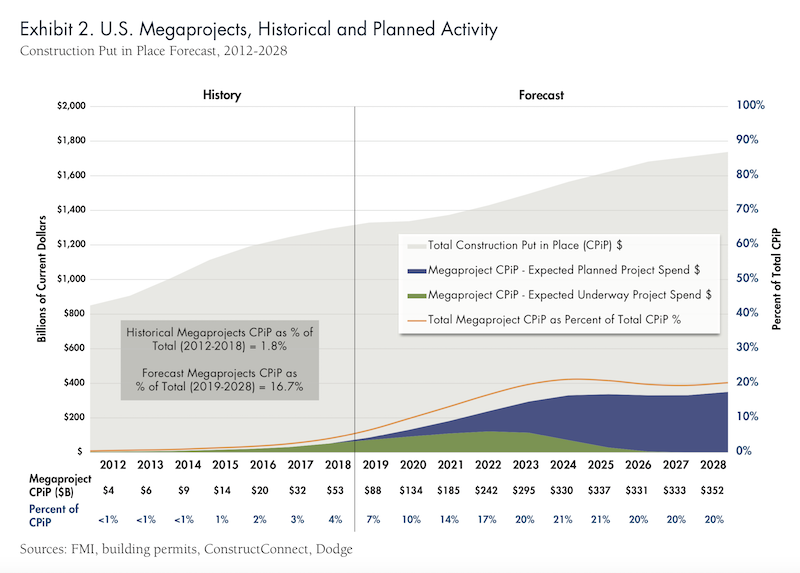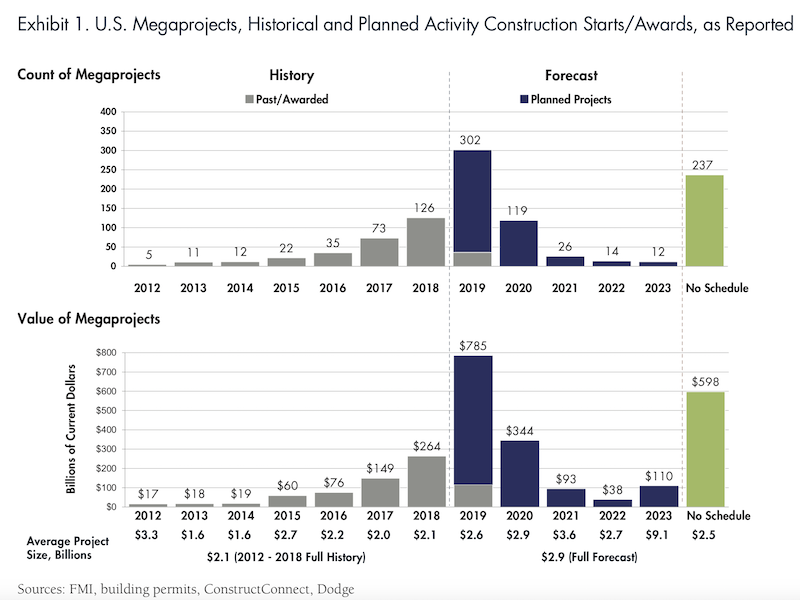Societies continue to move toward megacity cultures, lifestyles, and economies that are becoming more vital, in some cases, than the countries that spawn them.
One result of this trend has been a growing tendency among owners, developers, and their Building Teams to package smaller and multiple commercial projects into large, single megaprojects whose construction costs exceed $1 billion, in spite of such projects’ historically erratic success rates and shortcomings.
“Speed to market has become critical for owners. In addition, construction companies are getting larger, making it more feasible for them to handle bigger projects,” explains Ron Magnus, a founding Principal with the market research firm FMI, which has just come out with a new study titled “Megaprojects: Changing the Conversation.”
FMI’s report, authored by its content director Sabine Hoover, indicates that at least 320 megaprojects have been awarded in the U.S. alone since 2012—at an aggregate investment valued at over $700 billion.
Additionally, more than 670 megaprojects are being planned, a future investment opportunity likely to reach $2 trillion. Most of these planned megaprojects are expected to be built in the South and West, with three states accounting for 40% of the total starts value (New York, 15%; California, 15%; and Texas, 10%).

FMI predicts that megaprojects could account for 20% or more of construction spending within the next five years. Chart: FMI
Megaprojects have been expanding in number and value. Between 2013 and 2018, the annual value of U.S. megaproject starts increased from 3% to approximately 33% of all U.S. construction project starts. FMI predicts that, over the next decade, annual construction put in place on megaprojects will explode by nearly 600% to $350 billion.
Measured another way, megaproject construction put in place accounted for only 1.8% of total CPiP between 2012 and 2018. FMI estimates that within the next decade—and possibly within the next five or six years—annual megaproject spending could equal around 20% of total construction spending.
While FMI acknowledges that industrial and infrastructure starts have accounted for the bulk of megaproject starts (61% in 2018), it also sees more evidence of this trend in nonresidential building.

The value of megaproject starts could rise at an especially brisk clip over the next two years. Chart: FMI
The big question, though, is whether the industry is ready to meet this demand. Part of FMI’s research for this report included input from a roundtable of 22 stakeholders—AEC firms, owners, academics—that have engaged megaprojects in the past. From that discussion FMI gleaned five key success factors:
•Trust. Stakeholders on successful megaprojects invest a lot of time upfront in building trust through off-site meetings, getting to know each other on a personal basis. “Trust is the cornerstone, the basic building block,” says Jim Whitaker, FAIA, FDBIA, Principal and Senior Vice President with HKS Inc.
•Culture of Cohesion and Collaboration. DPR Construction on one megaproject spent two weeks with the owner and architect charting the work and setting up its organizational structure. By doing so, the team reduced that project’s budget by $200 million without yielding functionality, square footage, or quality.
Keith Molenaar, associate dean for research at the University of Colorado Boulder, in collaboration with the Pankow Foundation, has studied more than 200 different building projects and found that early collaboration was key to success. The delivery method chosen, on the other hand, had far less impact.
•Transparent and authentic leadership. Effective megaproject leaders, says FMI, are experts in developing a team environment that fosters emotional engagement, shared purpose and accountability.
•Nimble and autonomous teams. Successful megaproject teams are getting away from centralized management and are setting up smaller, more nimble project teams that can move quickly. “Like the platoon model for marines, these teams enjoy a certain degree of autonomy and are empowered to make decisions without approval from the top, and at each decision point,” says FMI.
•Educated and experienced owners. The report quotes Darin Daskarolis, senior director of Global Construction-Data Centers at Facebook, who notes that since commercial construction is largely a relationship-based business, “we knew we had to form strong bonds with our contractors to develop a common and realistic view of the challenges ahead. This common view informed sensible budgets and guided strategic staffing decisions.
The global strategist Parag Khanna sees a world that is becoming more connected by buildings and structures. So where global defense budgets and military spending total about $2 trillion per year, infrastructure spending is expected to increase from $3 trillion today to $9 trillion annually by 2030.
For the U.S., FMI forecasts that half of all megaproject spending over the next three to five years could occur in just 20 metros, and just five of these markets—New York, Los Angeles, Dallas, Houston, and Washington D.C.—will account for one-fifth of total construction in the country. But FMI also ends its report with a cautionary warning for the construction industry. “We have no choice but to completely change our mindsets. Should megaprojects continue to fail just as their spending is expected to reach new heights, the impacts could be devastating to the framework of the E&C industry.”
Related Stories
Industry Research | Jan 31, 2024
ASID identifies 11 design trends coming in 2024
The Trends Outlook Report by the American Society of Interior Designers (ASID) is the first of a three-part outlook series on interior design. This design trends report demonstrates the importance of connection and authenticity.
Apartments | Jan 26, 2024
New apartment supply: Top 5 metros delivering in 2024
Nationally, the total new apartment supply amounts to around 1.4 million units—well exceeding the apartment development historical average of 980,000 units.
Self-Storage Facilities | Jan 25, 2024
One-quarter of self-storage renters are Millennials
Interest in self-storage has increased in over 75% of the top metros according to the latest StorageCafe survey of self-storage preferences. Today, Millennials make up 25% of all self-storage renters.
Industry Research | Jan 23, 2024
Leading economists forecast 4% growth in construction spending for nonresidential buildings in 2024
Spending on nonresidential buildings will see a modest 4% increase in 2024, after increasing by more than 20% last year according to The American Institute of Architects’ latest Consensus Construction Forecast. The pace will slow to just over 1% growth in 2025, a marked difference from the strong performance in 2023.
Construction Costs | Jan 22, 2024
Construction material prices continue to normalize despite ongoing challenges
Gordian’s most recent Quarterly Construction Cost Insights Report for Q4 2023 describes an industry still attempting to recover from the impact of COVID. This was complicated by inflation, weather, and geopolitical factors that resulted in widespread pricing adjustments throughout the construction materials industries.
Hotel Facilities | Jan 22, 2024
U.S. hotel construction is booming, with a record-high 5,964 projects in the pipeline
The hotel construction pipeline hit record project counts at Q4, with the addition of 260 projects and 21,287 rooms over last quarter, according to Lodging Econometrics.
Multifamily Housing | Jan 15, 2024
Multifamily rent growth rate unchanged at 0.3%
The National Multifamily Report by Yardi Matrix highlights the highs and lows of the multifamily market in 2023. Despite strong demand, rent growth remained unchanged at 0.3 percent.
Self-Storage Facilities | Jan 5, 2024
The state of self-storage in early 2024
As the housing market cools down, storage facilities suffer from lower occupancy and falling rates, according to the December 2023 Yardi Matrix National Self Storage Report.
Designers | Dec 25, 2023
Redefining the workplace is a central theme in Gensler’s latest Design Report
The firm identifies eight mega trends that mostly stress human connections.
Contractors | Dec 12, 2023
The average U.S. contractor has 8.5 months worth of construction work in the pipeline, as of November 2023
Associated Builders and Contractors reported today that its Construction Backlog Indicator inched up to 8.5 months in November from 8.4 months in October, according to an ABC member survey conducted Nov. 20 to Dec. 4. The reading is down 0.7 months from November 2022.

















